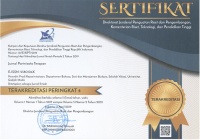Pengelolaan Pengunjung di Kawasan Wisata Alam Lolai Kabupaten Toraja Utara
Mia Rahayu(1*), Yudha Sakti Pratama(2)
(1) Politeknik Pariwisata Makassar
(2) Politeknik Negeri Lampung
(*) Corresponding Author
Abstract
Pong Torra’ is one of natural tourism attraction in Lolai Natural Tourism Area of North Toraja Regency, that is an expansion of Tana Toraja Regency, according the local regulation of Toraja Utara no. 7 in 2016. This district is focused on being developed as a tourism destination. A high level of tourist visits even reaches 1,000 visitors / day during the high seasons, tourism activities are increasing, while the limited space in the tourist area causes the density of visitors to the tourist area, which will continue to have a negative impact on both the visitor side and also the tourist attraction alone. In addition, according to the Decree of the Minister of Forestry of the Republic of Indonesia No.SK 434 / Menhut-II / 2009, Pong Torra 'is included in the Protected Forest Area of South Sulawesi Province. Therefore, it is necessary to implement visitor management.
Qualitative research methods are used to obtain data, through observation, interviews and questionnaire collection. In the visitor profile, it is done by looking at geographical, demographic and psychographic aspects, where from the visitor profile it is known that the dominant visitors traveling in Pong Torra 'are middle-aged / adult visitors, male gender and low of money spending and domestic tourist visits are the highest. In this study, a combination of hard (hard) and soft (soft) approaches was carried out. Through the hard approach, the researcher uses the tourism carrying capacity calculation, which results in a PCC value of 25 visitors / day and an RCC value of 30 visitors / day, from which this value indicates the number of tourist visits that have exceeded the visitor capacity threshold. Meanwhile, a soft approach is carried out by directing and educating visitors through information dissemination and interpretation. The two approaches to managing visitors are carried out using their respective techniques.
Keywords
Full Text:
PDFReferences
Albrecht, J.N. (ed.) (2017). Visitor Management in Tourism Destinations. Gramedia Pustaka Utama.
Badan Pusat Statistik. (2018). Kabupaten Toraja Utara Dalam Angka 2018. Kabupaten Toraja Utara: BPS.
Bafadhal, A.S. (2018). Perencanaan Bisnis Pariwisata (Pendekatan Lean Planning). Malang: UB Press.
Cole, D.N. dan Daniel, T.C. (2003). “The Science of Visitor Management in Parks and Protected Areas: From Verbal Reports to Simulation Models”. Journal for Nature Conservation. 11(270-275).
Damanik, J., Rindrasih, E. dkk. (2014). Membangun Pariwisata Dari Bawah. Yogyakarta: Gadjah Mada University Press.
El-Barmelgy, H.M. (2013). “Visitor Management Plan and Sustainable Culture Tourism”. International Journal of Education and Research. 12(4-9).
Fandeli, C., dan Suyanto, C. (1999). “Kajian Daya Dukung Lingkungan Obyek dan Daya Tarik Wisata Taman Wisata Grojogan Sewu, Tawangmangu”. Jurnal Manusia dan Lingkungan. 7(19):32-47.
Grant, M. (1994). “Visitor Management”. London. English Tourist Board.
Groot, R. (2006). “Function-Analysis and Valuation as a Tool to Assess Land Use Conflicts in Planning for Sustainable, Multi-Functional Landscapes”. Landscape and Urban Planning. 75(175-186).
Hadiansyah, M.N. (2017). “Kajian Faktor-faktor yang Mempengaruhi Aksesibilitas dalam Ruang Pelayanan Publik Studi Kasus: BPJS Kesehatan Cabang Utama Bandung”. Jurnal Desain Interior. 1(29-32).
Hadiwijoyo, S.S. (2012). Perencanaan Pariwisata Pedesaan Berbasis Masyarakat. Yogyakarta: Graha Ilmu.
Inskeep, E. (1991). Tourism Planning: An Integrated and Sustainable Development Approach. Ed. ke-1. Wiley Publishing, Inc.
Irianti, R.N. dkk. (2014). “Pengaturan Pengunjung dan Kenyamanan Wisatawan di Atraksi Wisata Taman Margasatwa Ragunan”. Journal of Tourism Destination and Attraction. 2(85-88).
Kebete, Y. dan Wondirad, A. (2019). “Visitor Management and Sustainable Destination Management Nexus in Zegie Peninsula, Northern Ethiopia”. Journal of Destination Marketing & Management. 13(83-98).
Kementerian Lingkungan Hidup dan Kehutanan. (2017). Statistik Direktorat Jendral Konservasi Sumber Daya Alam dan Ekosistem. Jakarta: Sekretariat Direktorat Jendral KSDAE.
Leask, A. (2010). “Progress in Visitor Attraction Research:Toward a More Effective Management”. Tourism Management Journal. 31(155-166).
Leo, S. (2013). Kiat Jitu Menulis Skripsi, Tesis dan Disertasi. Jakarta: Erlangga. Lincoln, Y.S. dan Guba, E.G. (1989). Fourth Generation Evaluation. Newbury Park: Sage Publications.
Lucyanti, S., Hendrarto,.(2013).“Penilaian Daya Dukung Wisata di Obyek Wisata Bumi Perkemahan Palutungan Taman Nasional Gunung Ciremai Provinsi Jawa Barat.” Jurnal Ekosains.
Marion, J.L. dan Farrell, T.A. (2002). “The Protected Area Visitor Impact Management (PAVIM) Framework: A Simplified Process for Making Management Decisions”. Journal of Sustainable Tourism. 1(33-46).
Marpaung, H. (2016). Pengetahuan Kepariwisataan. Bandung: CV Arfino Raya. Pendit, Nyoman.S.(1994). Ilmu Pariwisata: Sebuah Pengantar Perdana. Surabaya: Pradnya Paramita.
Purwanti, A. (2015). “Penataan Objek Wisata sebagai Strategi Komunikasi Dinas Pariwisata dan Kebudayaan dalam kegiatan Visit Batam 2010”. Jurnal Komunikasi. 2(20-40).
Purwanti, N.D. dan Dewi, R.M. (2014). “Pengaruh Jumlah Kunjungan Wisatawan terhadap Pendapatan Asli Daerah Kabupaten Mojokerto tahun 2006-2013”. Jurnal Ilmiah. 1-4.
Yoeti, Oka.A. (1985). Pengantar Ilmu Pariwisata. Bandung: Angkasa. Dalam. Muksin, I. Ketut. 2016. Pemanduan Wisata Alam dan Ekowisata. Denpasar:Unud.
Internet
Benefit dan Parks. (2013). European Regional Development Fund: Visitor Management Strategy. http://www.parksandbenefit.net/images/stories.html
Bupati Toraja Utara. (2016). Peraturan Daerah Kabupaten Toraja Utara No. 7 Tahun 2016 tentang Penyelenggaraan Kepariwisataan. Kabupaten Toraja Utara. Akses 25 Oktober 2019.
Human, B. dan Sharp, P. (2010). Tourism and Planning: The Planning System. Januari, 2020 http://www.insights.org.uk/articleitem.aspx?title=Tourism-and-Planning-Part-1%3a-ThePlanning–System
Republik Indonesia. (1990). Undang-undang No. 9 Tahun 1990 tentang Kepariwisataan. Presiden Republik Indonesia. Jakarta. Dari http://jdih.baliprov.go.id/uploads/produkhukum/peraturan/1990/UU/uu-9-1990.pdf. Akses 25 Oktober 2019.
Republik Indonesia. (2008). Undang-undang No. 28 Tahun 2008 tentang Pembentukan Kabupaten Toraja Utara di Provinsi Sulawesi Selatan. Dari http://www.dpr.go.id/dokjdih/document/uu/UU_2008_28.pdf. Akses 25 Oktober 2019.
Republik Indonesia. (2009). Undang-undang No. 10 Tahun 2009 tentang Kepariwisataan.
Presiden Republik Indonesia. Jakarta. Akses 25 Oktober 2019.
Republik Indonesia. (2013). Undang-undang No. 18 Tahun 2013 tentang Pencegahan dan Pemberantasan Perusakan Hutan. Presiden Republik Indonesia. Jakarta. Akses 27 Februari 2020.
Republik Indonesia. (2016). Keputusan Menteri Lingkungan Hidup dan Kehutanan tentang Penetapan Lokasi Fasilitasi Pada Tiga Unit Kesatuan Pengelolaan Hutan Lindung di Provinsi Sulawesi Selatan. Menteri Lingkungan Hidup dan Kehutanan Republik Indonesia. Jakarta. Akses 13 Februari 2020.
Article Metrics
Refbacks
- There are currently no refbacks.
Copyright (c) 2023 Mia Rahayu, Yudha Sakti Pratama

This work is licensed under a Creative Commons Attribution-ShareAlike 4.0 International License.













